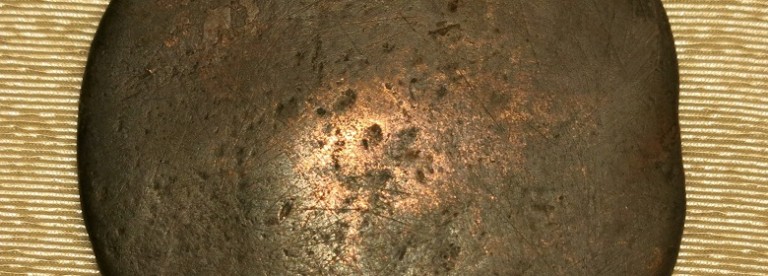
February 2016
John Vincent Bellezza
Welcome to Flight of the Khyung as we continue to chart the treasures of the ancient Western Tibetan Plateau! On this and next month’s journey we visit bronze objects of stunning beauty and rarity. Many things you will see and read about in these newsletters, art historical and archaeometallurgical, can be found nowhere else.
The article on early bronze metallurgy in Tibet in this and next month’s newsletter was written with the support of the Shelley & Donald Rubin Foundation and the Asian Cultural Council, New York. I am most grateful to these noble institutions for their continued support of my scholarly work.
I want to thank those who contributed photographs or permitted me to take them of ancient Tibetan bronzes in their collections. Contributors include an impressive group of collectors and connoisseurs such as David Salmon, Moke Mokotoff, Bob Brundage, Carol Yong, and Amdo Tsegyal. Other contributors prefer to remain anonymous.
I would also like to thank the distinguished scholars who helped me obtain publications needed to complete the February and March newsletters: Esther Jacobson-Tepfer (University of Oregon), Victor Mair (University of Pennsylvania), Jianjun Mei (Cambridge University), and Martin Heijdra (Princeton University).
Featured in Part 2 of this article is an object from the collection of the late Shang Nyima. Shang Nyima, an old friend, passed away in Lhasa in 2015. He was a cultured, extremely intelligent and high spirited individual of uncommon integrity. Over the course of many years, Shang Nyima freely shared with me his formidable knowledge of Tibetan history and culture, and he was a generous supporter of my research work.
Also see next month’s newsletter for the second part of this article: “A Preliminary Study of the Origins and Early Development of Bronze Metallurgy on the Western Tibetan Plateau. Part 2: Intercultural contacts in the Bronze Age and Iron Age, an archaeometallurgical perspective.”
A Preliminary Study of the Origins and Early Development of Bronze Metallurgy on the Western Tibetan Plateau
Part 1: The ‘Eurasian animal style’, an art historical perspective
Abstract
An analysis of a broad range of art historical and archaeological evidence indicates that the pre-Buddhist corpus of Tibetan bronze objects known as thokchas originated from a cross-fertilization of technological and ideological elements of the Northern Metallurgical Province of the Late Bronze Age and Scythic cultures of the Iron Age with the creative capabilities of autochthonous Tibetan cultures.
Introduction to the Eurasian Animal Style
There are little known genres of pre-Buddhist Tibetan art characterized by a vibrant cosmopolitanism, drawing the Plateau into the wider orbit of Eurasian cultural and technological affairs. Links between material forms on the Western Tibetan Plateau (Ladakh, Spiti and Upper Tibet) and other continental territories can be traced back to the Late Bronze Age (circa 1200–700 BCE) and the early and developed Iron Age (ca. 700–100 BCE). This shared artistic and technological bequest transcended the bounds of many local cultures and societies to permeate the heart of Asia.
Among the earliest examples of cosmopolitan art forms in both south Inner Asia (Tibetan plateau and the Himalayan rim-land) and north Inner Asia (Kazakhstan, Xinjiang, Southern Siberia, Mongolia, Qinghai, and western Gansu) are chariot and mascoid (anthropomorphic figures in emblematic form) rock carvings.* They are found together on the Western Tibetan Plateau and in sundry regions to the north. Chariot and mascoid petroglyphs in north Inner Asia are commonly assigned to the Bronze Age (late and middle phases respectively). However, there is a lack of verifiable chronological data for this rock art; therefore, prudence may dictate entertaining a somewhat later date for Tibetan examples.†
The animal style art of western Asia and Europe is beyond the scope of this paper.
For chariot and mascoid carvings in Upper Tibet (sTod and Byang-thang) and their associations with the rock art of north Inner Asia, see:
Bellezza, John V. 2008: Zhang Zhung: Foundations of Civilization in Tibet. A Historical and Ethnoarchaeological Study of the Monuments, Rock Art, Texts and Oral Tradition of the Ancient Tibetan Upland. Wien: Verlag der Österreichischen Akademie der Wissenschaften. See pp. 193–196.
____2010: “Riding High: The chariots of ancient Upper Tibet”, in Flight of the Khyung, August 2010.
____2011: “Revisiting the chariots of Upper Tibet”, in Flight of the Khyung, November 2011.
____2011: “The Individual or Group in Emblematic Form: The mascoids of Upper Tibet”, in Flight of the Khyung, December 2011.
2014: The Dawn of Tibet: The Ancient Civilization on the Roof of the World. Lanham: Rowman & Littlefield. See pp. 127, 182, 195, 196.
Bruneau, Laurianne and Bellezza John V. 2013a. “The Rock Art of Upper Tibet and Ladakh: Inner Asian cultural adaptation, regional differentiation and the ‘Western Tibetan Plateau Style’”, in Revue d’etudes tibétaines, vol. 28, pp. 5–161. Paris: CNRS. http://himalaya.socanth.cam.ac.uk/collections/journals/ret/pdf/ret_28.pdf
Evidence for early cosmopolitanism on the Western Tibetan Plateau (WTP) is also represented by rock carvings in the genre of art commonly known as the ‘Eurasian animal style’ or simply ‘animal style’, a heterogeneous tradition of zoomorphic figuration characterized by curvilinear schemata and motifs. As in north Inner Asia, the Eurasian animal style of the WTP consists largely of deer and other wild ungulates, raptors and carnivores. Cross-cultural comparisons indicate that this graceful and dynamic form of art in uppermost Tibet, Ladakh and Spiti arose in the Iron Age (ca. 700–100 BCE). It persisted on the WTP into the Protohistoric period (ca. 100 BCE to 600 CE).*
For Eurasian animal style rock art on the WTP, see:
1) Francfort, Henri-Paul / Klodzinski, Daniel / Mascle, Georges. 1992: “Archaic petroglyphs of Ladakh and Zanskar”, in Rock Art in the Old World. Papers presented in Symposium A of the AURA Congress, Darwin Australia. 1988 (ed. M. Lorblanchet), pp. 147–192. Delhi: Indira Gandhi National Centre for the Arts.
2) Bellezza, John V. 2002: Antiquities of Upper Tibet: An Inventory of Pre-Buddhist Archaeological Sites on the High Plateau. New Dehli: Adroit. See pp. 136–139.
3) Bruneau, Laurianne. 2006-2007: “Preliminary Study of Rock Art of the Western Himalayas”, in Puratattva (Bulletin of the Indian Archaeological Society), vol. 37, pp. 101–111. New Delhi.
4) Bellezza 2008, ibid., pp. 191–194.
5) Bruneau, Laurianne. and Vernier, Martin. 2010: “Animal style of the steppes in Ladakh: A presentation of newly discovered petroglyphs”, in Pictures in Transformation : Rock art Researches between Central Asia and the Subcontinent (L. M. Olivieri et al.), pp. 27–36. Oxford: BAR International Series 2167. Oxford: Archaeopress.
6) Li Yongxian. 2001: Xizang Yuan Shi Yi Shu. Hebei: Jiao Yu Chu Ban She.
7) Lü Hongliang. 2010: “Xi Ximalaya yanhua Ou Ya caoyuan yinsu zai jiantao” (A Reexamination of Eurasian Steppe Elements in the Petroglyphs of the Western Himalaya Region)”, in Kaogu vol. 10, pp. 76–85. Beijing.
8) Bruneau, Laurianne and Bellezza, John V. 2013a.
9) 2014: “Sinuous Shapes: The Eurasian animal style rock art of Upper Tibet”, Parts 1 and 2, in Flight of the Khyung, October and November, 2014.
10) 2015: “Visitations from Upper Tibet and Ladakh: A survey of trans-regional rock art in Spiti”, in Flight of the Khyung, August 2015
11) Bellezza, John V. Forthcoming. “Discerning Bon and Zhang Zhung on the Western Tibetan Plateau: Historical and cultural questions pertaining to archaeological nomenclature in the study of ancient rock art in Upper Tibet, Ladakh and Spiti”, for International Conference of Shang Shung Cultural Studies, Beijing, September 18–21, 2015.
The Eurasian animal style in Tibet is also vividly encapsulated in artifacts made of bronze (for the purposes of this article: copper alloys of all types).* These objects were cast in molds (open and bivalve) and are ornamented with wild ungulates (deer, ibex or antelopes, wild yaks), hares, tigers, and birds executed in a bold and fluid style. In Tibetan parlance, these kinds of bronze things are known as thokcha (primordial metal; thog-lcags) or thogde (primordial little stone missiles; thog-rde’u). These terms stress the primal and celestial origins of the objects. In Tibet thokchas are believed to have protective and good-fortune bestowing functions. They have been discovered, worn and traded for centuries.
For another study of bronze objects in the Tibetan animal style, see December 2014 Flight of the Khyung. For Eurasian links to the bronze metallurgy of Tibet, also see May 2014 Flight of the Khyung.
The thokchas featured in this article are comparable in form and subject matter to rock art in the animal style of the WTP. This indicates that these two material categories are culturally and chronologically interrelated. The occurrence of the animal style art in two different media suggests that this kind of presentation and the ideologies and sensibilities incumbent in it impregnated the cultural fabric of the WTP. Given the relatively diverse expression of the animal style in the region, we should consider the prospect they it might have been represented in more perishable media as well.
Related objects and esthetic traditions in the animal style, expressed in the media of bronze, gold, wood, stone, felt, and other materials, are well known in north Inner Asia and other regions of Eurasia. Nevertheless, the bronzes from Tibet explored in this article constitute a distinctive branch of the animal style, an artistic tradition with its own set of distinguishing stylistic and thematic elements and attendant semantics.
A selection of animal style bronzes of the Western Tibetan Plateau
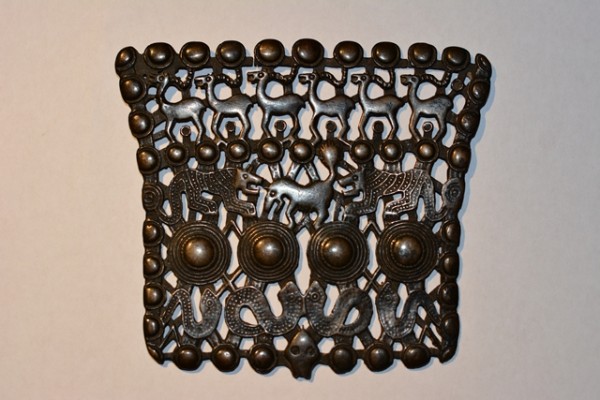
Fig. 1. A trapezoidal openwork copper alloy plaque, Tibet. It features rows of animals interspersed between lines of shield-like discs. The three rows of animals are comprised of (from top to bottom): six antelopes or ibexes, two tigers flanking an onager and four serpents. This specimen is noteworthy for its fine patina, indicative of long-term conservation in a sheltered environment. Probably Iron Age. Collection of David Salmon, UK. Photo courtesy of Alex Salmon.
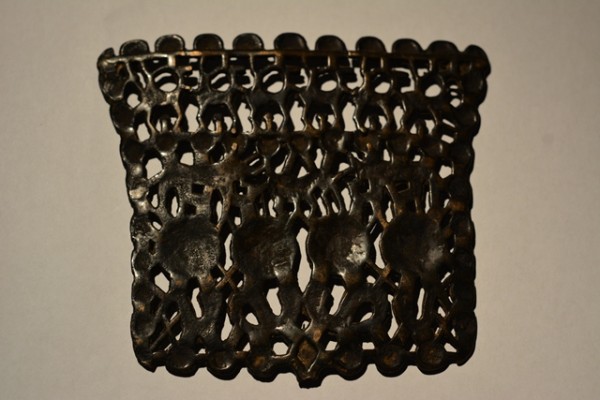
Fig. 2. The reverse face of the same thokcha object in fig. 1. The precision casting of this bronze object is readily seen from this perspective. The object exhibits much uniformity with no discontinuities in casting or unfinished sections. Collection of David Salmon, UK. Photo courtesy of Alex Salmon.
The thokcha from the David Salmon collection boasts not only animal style forms but a carnivore attack scene prominently placed in the middle of the bronze. Felines, griffons and other carnivores attacking wild ungulates are well represented in animal style bronze and gold objects of north Inner Asia. The styles of zoomorphic depiction in north Inner Asia, however, tend to be more lithe and sinuous than Tibetan variants and include animals in fantastic poses never seen in Tibetan thokchas. Tibetan animal style art is more stolid in form but with an elementary beauty that is powerful and iconic.
Only a few examples of this type of flabelliform thokcha have been documented.* Those known to me were sourced from the international art and antiquities market and lack a firm provenance. Interviews carried out with Tibetan dealers over the last 20 years indicate that wares such as the Salmon thokcha were obtained in far western Tibet. That they are consistently attributed to the WTP strongly suggests production in that area. We can probably thus conclude that the thokcha in the Salmon collection and others like it represent an artistic, cultural and technological product unique to ancient Tibet and more specifically to the WTP.
For other examples, see December 2010 Flight of the Khyung, fig. 10–12.
The sophisticated modeling and manufacture of the thokcha in the Salmon collection is clearly the product of a mature metalworking tradition. This presupposes the existence of well-developed metallurgical capabilities on the WTP, encompassing mining operations, transport of ores, and smelting and fabrication technologies in foundries (i.e., casting, annealing, work hardening, etc.). The fluent modeling of the various figures, intricate decorative details, and highly adept openwork casting, chasing, and careful finishing are indicative of considerable refinement in the metalworking traditions of the region.*
This thokcha may well be made of a tin-bronze alloy but an alloy of zinc-copper (brass) cannot be ruled out from a visual appraisal alone. Metallurgical analysis of archaic Tibetan bronze objects is called for, including an investigation of the sources, extraction techniques, foundry locations, composition and structure of copper alloys and their corrosion byproducts, manufacturing technologies, etc.
The function of the animal style bronze under examination has not been determined. Most objects of this class have a stem or haft extending from the middle of the base, indicating that they were not worn as personal decorative objects but somehow displayed by erecting them vertically. The example from the Salmon collection appears to have had a stem but it has broken off, leaving just the base in place. This base appears to be adorned with an animal head. The stand on-its-own display function inferred by a stem hints at such objects being used ritualistically or ceremonially.
The animals represented on these kinds of ancient bronzes (felines, wild ungulates, hares and snakes) have a wide range of identities and functions in Tibetan literary and ethnographic records, including many numinous aspects. Elemental and personal deities (territorial, genealogical, tutelary, etc.) appear in the guise of species depicted on thokchas. Wild ungulates, tigers and serpents figure prominently in many ancient Tibetan myths and rituals and also have semi-divine and demonic personae.
The vertical arrangement of animals on bronzes like the one in the Salmon collection is in keeping with cosmological conceptions still prevalent in Tibet. The horns of deer and wild antelope are seen as touching the celestial realm of divine spirits (lha), while felines embody terrestrial spirits (e.g., btsan and gnyan) and the world of subterranean spirits (klu) manifests as serpents. The numerical arrangements of animals on the trapezoidal bronzes can also be correlated to Tibetan mythic and cosmological symbolism.
The Salmon thokcha is unique for its predator attack scene. Here two long-tailed felines are shown attacking what appears to be an onager (rkyang), identified by the erect ear, large, rounded neck, blunted head, and body shape.* The stylized bushy tail of the doomed animal sticks straight up in terror. Mouth agape, its head points downward in a defensive stance. The marauding felines are depicted coming in for the kill as they pounce upon their prey, fangs bared. There are rows of spots sandwiched between the bending lines covering the body and legs. The long curved tails of the carnivores terminate in spirals along the two edges of the object. The feet of these creatures sport claws. The most likely species identification for this striped animal is the tiger, although the leopard or snow leopard cannot be ruled out entirely.†
A late Scythic plaque depicting a feline attacking an equid attributed to the Sino-Steppe borderlands region of Ordos and dated to the 4th century BCE is depicted on a Wikipedia page:
https://en.wikipedia.org/wiki/Scythian_art#/media/File:HorseAttackedByTigerOrdos4th-1stBCE.JPG
For an Ordos bronze plaque of the same theme but in a considerably different style, see:
http://pages.uoregon.edu/jsimic/reserve/88-9661.gif
Tigers attacking wild ungulates such as wild yaks are also known from the rock art of far western Tibet. See August 2012 and January 2014 Flight of the Khyung. Also see March 2012 Flight of the Khyung, figs. 9, 10.
We can assume that the carnivore attack scene on the bronze in the Salmon collection carried mythic, narrative and/or symbolic overtones, the precise nature of which is beyond our capacity to ascertain. Rather than merely a fact of natural history, the primary significance of the depiction may have been sociopolitical (in either a mythic or everyday context). The blatant aggression portrayed in the carnivore attack portrayal can be connected to ancient martial traditions on the WTP. This savagery could possibly communicate ideological, ritualistic or symbolic themes pertaining to ancient warriors and warfare such as bravery, prowess, conquest, and leadership.
Aside from its dramatic conveyance of ideas and activities, the feline attack scene furnishes some indication of the age of the Salmon bronze. As with analogous compositions in animal style artifacts of north Inner Asia, this thokcha is best dated to the Iron Age (ca. 600–100 BCE). Likewise, on art historical grounds, cognate rock art suggests an Iron Age date. Nevertheless, it must be kept in mind that the subsequent Protohistoric period (ca. 100 BCE to 600 CE) was to an undetermined degree a carryover of Iron Age cultural universe in much of Tibet.* Hence, a later date for the manufacture of the Salmon specimen must be entertained.
Specific benchmarks (stylistic, thematic, technical, etc.) differentiating the Tibetan Iron Age from the Protohistoric period are still inadequate. Progress in fixing periods is seriously hampered by the lack of early Tibetan figurative bronzes in secure archaeological contexts.
The four S-shaped serpents in the lower row of the Salmon thokcha are embellished with spots representative of scales and the kinds of patterns they produce. The two middle serpents are confronted. The snakes are shown head oriented upward with one large circular eye in each. Between them and the predator scene are four shield-like discs. The outer portion of these discs is circumscribed by concentric circles while the middle portion is hemispherical. Rows of smaller and more simply rendered discs make up the four edges of the object and there is a row of like discs interspersed between the felines and the upper row of animals.
The identity and function of the circular motifs on the bronze is unknown (relying on Tibetan ethnographic and textual sources a number of hypotheses concerning them can be formulated but these remain speculative). On the rear of two of the discs in the row between the attack composition and line of wild ungulates above are remains of attachment bars (see fig. 2). These attachment points are symmetrically arrayed on the fourth disc from the two vertical edges of the bronze. These must have been used in conjunction with the stem to support or suspend the object during usage.
The antelopes or ibex of the upper row of animals are identifiable by their furrowed horns. The horns curl back and downward from the base but then turn straight up towards the ends. Ibex horns in mature males generally point out and downward.* The horns of Tibetan male antelope generally stick straight up but the lower portion in larger animals often curves back slightly. The horns of wild herbivores portrayed on the thokcha have an exaggerated form, but in a manner that most parallels the geometry of the antelope’s. A major reason for the peculiar depiction of the horns may simply be space limitations on the object. The top row of ungulates in the examples of such objects I have seen is presented in the same manner as the Salmon bronze, offering no further clue as to the identification of the species portrayed.
In animal style art of north Inner Asia, ibex horns usually form arcs or complete circles and point downward or towards the head.
The presence of what appear to be antelopes helps geographically place the Salmon bronze. This species is restricted to Upper Tibet (sTod and Byang-thang regions) and Upper Ladakh. On the other hand, the range of the ibex does not extend into Upper Tibet except perhaps at the very border with Ladakh and Spiti.
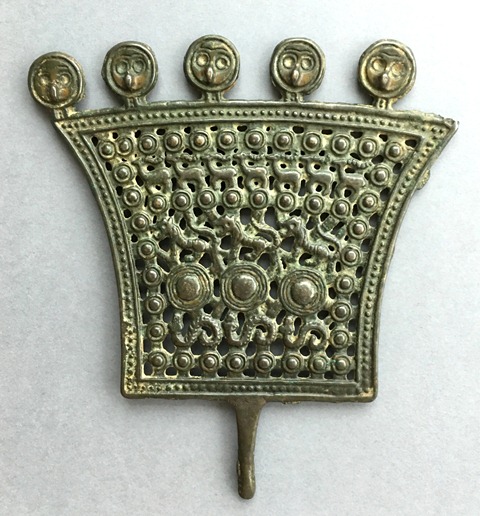
Fig. 3. Trapezoidal openwork animal style thokcha (13 cm in height), Tibet. The three rows of animals in profile (from bottom to top) are snakes (3), tigers (3) and antelope / ibex (7). On the top of the object is a series of round bird heads. Private collection. Probably Iron Age.

Fig. 4. The reverse face of the same object as in fig. 3.
In terms of provenance, age, function, symbolism and significance, this animal style thokcha is equivalent to the Salmon specimen. The verdigrisy patina, however, indicates that this trapezoidal bronze was excavated, perhaps from an ancient tomb. This object exhibits a somewhat different selection of animal motifs from the Salmon specimen.
The trio of snakes in the bottom row of the bronze has the same form and aspect as the snakes on the Salmon thokcha. The felines in the second row face left and are shown with mouths fully open, fangs bared. The body of these carnivores is striped and they have long curling tails that overarch the back. These decorative details indicate that the felines depicted are almost certainly tigers. The third row consists of probable antelopes with the same style horn and body as is regularly depicted on bronzes of this class.
The snakes (’brul), tigers (stag) and antelopes (gtsod) and their style of depiction constitute the most common zoomorphic subjects in flabelliform openwork thokchas. Birds gracing the top of these objects are also a conventional attribute. However, the rendition of birds on the top of this bronze is unusual. Only the circular heads of the birds are depicted. With their round eyes and pointed beaks, these birds most resemble owls. There were once six bird heads on the bronze but one is now missing.
The rows of discs adorning the thokcha are comparable to the Salmon specimen and other examples. They vary slightly in details but this is very unlikely to have had any bearing on the significance or function of the object. The four edges of the thokcha are embellished with a series of nubs rather than discs. These nubs are set between the raised linear edges of the object. Decorative treatment consisting of nubs or eyes is common in pre-Buddhist thokchas. The stem (if it was planted vertically) or haft (if it was attached to a larger object) is fully intact. Over the centuries this accoutrement often became damaged or completely lost.
Birds (especially raptors) play an important role in the rock art, textual traditions and ethnography of the WTP, especially in Upper Tibet. Birds serve as emissaries of deities and assume divine forms in their own right. Birds are mostly associated with the upper realm of the cosmos (steng) but some aquatic birds have chthonic connotations. Mountain gods, warrior spirits, clan protectors and tutelary gods are all believed to emanate as birds. Tales abound in Tibet of ancient saints, priests and spirit-mediums manifesting as birds to carry out extraordinary activities. Birds also figure in a wide assortment of rituals including those for appeasement, protection, good luck, destructive magic, and funerals.
Tigers are also a cardinal animal in Tibetan cultures, particularly in its more martial cast. Tiger spirits participate in the trance ceremonies of spirit-mediums in Upper Tibet, and tiger-faced gods and demons are an integral part of Tibetan religions. Clothing and headgear made from tiger pelts occupy a hoary place in the history of Tibetan dress.*
There has been some speculation in Tibetology that the tiger was introduced into Tibet by the Chinese in the Imperial period (629–852 CE), but the occurrence of the tiger in much earlier rock art and bronze artifacts belies this assertion. This sort of Sino-centrism is the counterpart to an Indo-centric view of Tibetan cultural origins. The effect of seeing Tibetan cultural genesis exclusively in these terms is to strip away a sense of Tibetan-ness, which extends deeper in the past than the era of Indian and Chinese Buddhist cultural inputs. In their most extreme form, Indo-centrism and Sino-centrism hold that Tibetans could not have possibly recorded in their literature elements of their cultural and historical experience that predate the 6th or 7th century CE.
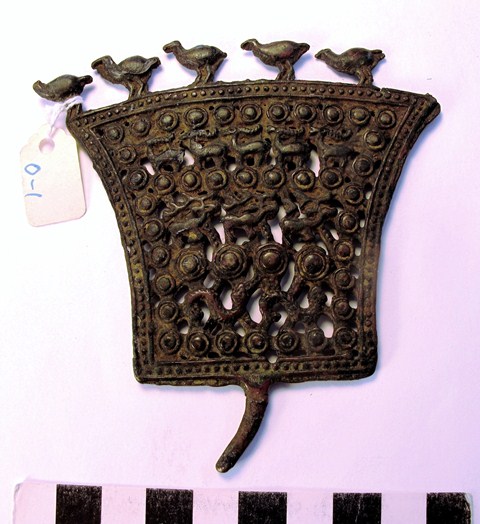
Fig. 5. Trapezoidal openwork animal style thokcha, Tibet. The animals shown in profile on this object are (from bottom to top) snakes (2 examples), stags (3), antelope / ibex (5), birds (6). Probably Iron Age. Collection of Moke Mokotoff, New York.
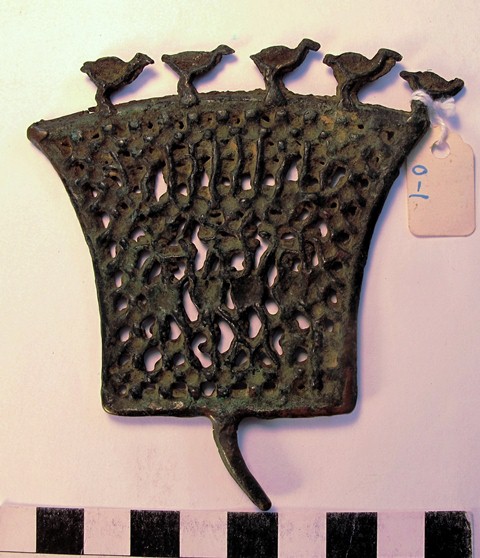
Fig. 6. The reverse face of the object in fig. 5. The adroit casting of this thokcha is readily seen from this perspective.
Evidently, the thokcha in the Moke Mokotoff collection was unearthed. The corrosion sustained by this object suggests that it was buried in a relatively unprotected environment. This thokcha was purchased in Tibet in the mid-1980s.
The snakes and probable antelopes of the Mokotoff bronze possess the same style and aspect as the other two objects we have examined. However, instead of carnivores the middle row of the thokcha is comprised of stags (sha-pho), identifiable through the branched antlers. The front legs of the stags are folded, simulating the swift movement (running or flying) of the animal. The horns completely overarch the back of the stags. Deer in various styles including those comparable to ones on this bronze are found in the rock art of the WTP, particularly in Upper Tibet.
Originally six standing birds adorned the top of the Mokotoff thokcha but one has broken away. It is not clear what species of birds was intended. Their position on top of the thokcha conforms to a cosmological scheme of great persistence in Tibet. The decorative discs and nubs and short stem of the bronze are of the type we have already encountered.
Deer played a prominent role in the religious life of ancient Tibet, as indicated in textual and ethnographic accounts. They enjoyed a pivotal position in ancient origins myths and ritual performances, often as a good luck attracting device. Like birds, deer were of special significance in archaic funerary rites, acting as ransom offerings to infernal demons, vehicles to transport the dead to the afterlife, and as provisions for upkeep in the otherworld.
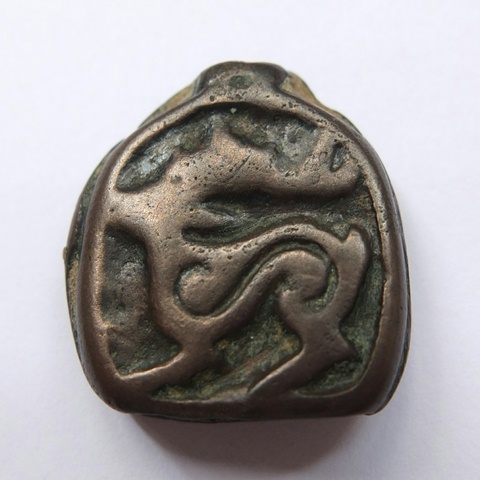
Fig. 7. Small copper alloy object embossed with stag in the Eurasian animal style (2.2 cm x 2.2 cm). Iron Age or Protohistoric period. Carol Yong collection, Hong Kong. Photo courtesy of Carol Yong.
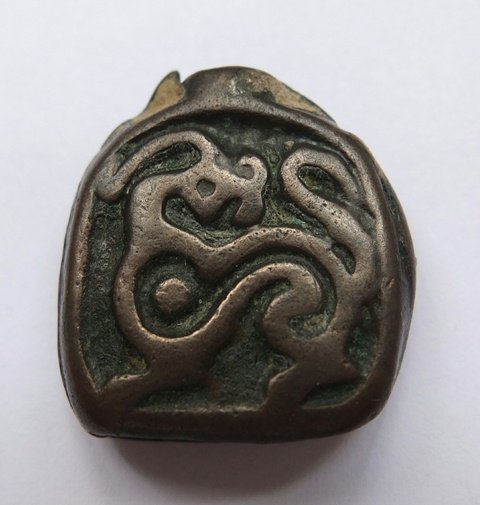
Fig. 8. The other side of the object in fig. 7. This side of the object is embossed with what appears to be either a dragon or feline. Photo courtesy of Carol Yong.
Please note that the description of this object was revised in April 2018.
The object in the Yong collection is hollow in the middle and was cast in a bivalve mold. This relatively thick-walled object appears to have been an equestrian accoutrement, a component of ritual or military equipment, or part of some other kind of ensemble. It carries a fine, lustrous patina, suggesting that it has been handed down over generations as an heirloom.
The Yong object features two animals in a variant of the Eurasian animal style that mimics art on bronze Chinese narrative vessels of the Eastern Zhou period (770–221 BCE). These adeptly modeled creatures with their flexed legs appear to be shown running or flying. The various motifs exhibited by these figures recall other examples of animal style art in Tibet and in north Inner Asia. Originally, I though this object belonged to the Tibetan Plateau but have revised my opinion and assign it to Inner Mongolia or northwestern China. It may however have ended up in Tibet long ago and kept as an heirloom, accounting for its good condition. I think the Yong object was either made by the Chinese for a nomadic region to the north or west, or by pastoralists in this territory who copied the canonical features of Eastern Zhou art.
The bodies of the stag and fantastic animal on either side of the object are adorned with a double volute motif. The double volute is relatively common in the rock art of northwestern Tibet (Ruthok) and Ladakh, where it is used to ornament or accentuate the bodies of deer, antelope and yaks. The double volute motif is also found to a lesser extent in the rock art of northeastern Tibet (Amdo). Nevertheless, the double volute motif on the Yong object is more in keeping with iconographic patterns on bronze vessels of the Eastern Zhou period. In north Inner Asia, single volutes often appear on the front and rear haunches of animals. Double volutes are an unusual stylistic trait in Tibetan bronze objects, although single volutes persisted as a decorative motif until the Early Historic period (ca. 600–1000 CE) and even more recently.
The stag on the Yong object has a single broad antler that stretches horizontally over the entire body. This style antler is more in keeping with this motif in the eastern steppes than Chinese deer art of the Eastern Zhou period. Exaggeratedly large antlers oversailing the body of a stag is a prominent motif in the petroglyphs and portable art of Mongolia and southern Siberia, metal plaques and figurines of the Xiongnu, and deer carved on wooden pails discovered in tombs of the Tarim Basin, all dating to the Iron Age. This mode of antler depiction is less common in the rock art of northwestern Tibet. The conspicuously protruding ear of the Yong thokcha also shares affinities with Scytho-Siberian art (metal objects, deer stones, etc.), but is also comparable to stags on a trapezoidal thokcha (fig. 5). A peculiar motif that the Yong object and some deer rock art in the animal style in northwestern Tibet have in common is the short, upright tail.
The animal on the reverse side of the Yong bronze seems to have the long tail and body of a feline and the head and horn of a dragon. In any case, this is the likeness of a powerful creature. The head of this animal is swung back to face its body, a common posture in Eurasian animal art. The hornlike motif above the head is a distinctive trait of Eastern Zhou feline art.
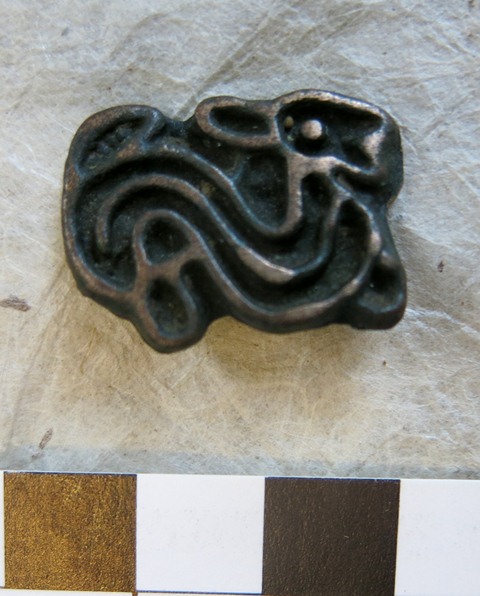
Fig. 9. Thokcha featuring what appears to be a hare (2.7 cm x 2 cm), Tibet. Iron Age or Protohistoric period. Private collection, UK.
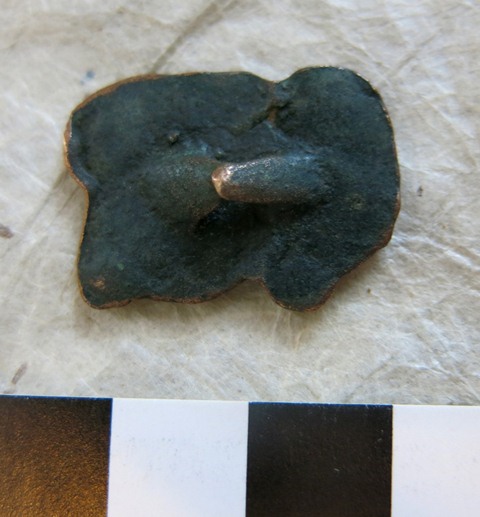
Fig. 10. The reverse side of thokcha in fig. 9. Note the attachment device formed from two separate tongues of metal.
The large, rounded ear and bobbed tail of this thokcha signal that it is probably the likeness of a hare (ri-bong).* Graceful yet robust, this animal is a quintessential Tibetan animal style depiction. Generally speaking, hares are rare in Tibetan thokchas. On the other hand, hares are a common subject in so-called Ordos plaques and figurines made in gold and bronze. The Tibetan bronze object (figs. 9, 10) is most likely to have been made in either northwestern or northeastern Tibet.
For another Tibetan example, see December 2014 Flight of the Khyung, fig. 7.
The thokcha (figs. 9, 10) has a series of deep grooves, creating a curvilinear pattern extending across the entire animal. The S-shaped body contours and central motif identify this object as belonging to the animal style. Tiny bronzes with grooved patterns form an important genre of thokchas, although no others in a patently Eurasian animal style appear to have been published.* Most grooved thokchas have a series of rectilinear and/or curvilinear configurations, some forming geometric patterns of considerable complexity. In addition to abstract forms, birds are common among this group of miniature bronzes.
For this genre of thokchas, see:
P. 62 (fig. 66) of Bellezza, John V. 1998. “Thogchags: Talismans of Tibet” in Arts of Asia, vol. 28 (no. 3), pp. 44-64. Hong Kong.
P. 138 (figs. R-335–R-337), 238 of John, Gudrun. 2006. Tibetische Amulette aus Himmels-Eisen. Rahden: Verlag Marie Leidorf.
P. 88 (left side) of Lin, Tung-Kuang. 2003. Antique Tibetan Thogchags and Seals (trans. B. Li). Taiwan: Liao, Yue-Tao.
Grooved thokchas have two major types of attachment clips on the reverse side: one consisting of two flaps of metal joined at the tips and a more common type consisting of a well-formed integral loop. A typological survey conducted (based on an analysis of stylistic and design traits of over 100 objects of this class) indicates that the more rudimentary clips consisting of two separate tongues of metal preceded the advanced type of integral fastening devices. Perhaps on these grounds, the hare thokcha can be ascribed to the Iron Age, but archaeological sequenced materials are required to corroborate this assertion.

Fig. 11. A disc-shaped thokcha with a pair of nubbed scrolls and thin attachment loop in the middle (approximately 70 cm in diameter) of the object. The rim of the object is similarly nubbed. This object is probably from the Tibetan plateau. Late Bronze Age or Iron Age. Amdo Tsegyal (A-mdo tshe-rgyal) collection, Amdo.
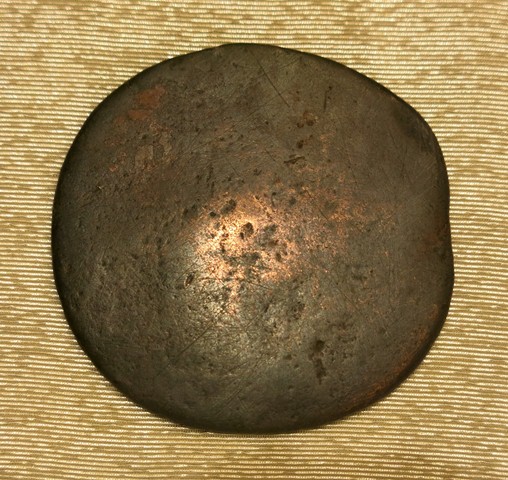
Fig. 12. The reverse of the thokcha in fig. 11. This undecorated face of the object is slightly curved.
The ornamentation of this thin, circular thokcha is dominated by a pair of embossed scrolls. As we have seen, scrolls ornamenting the bodies of wild ungulates carvings also occur in northwestern Tibet as an animal style motif. Thus we can see the Tsegyal thokcha as being allied to this genre of ancient art. Scrolls and spirals are found in the petroglyphs of Spiti, Himachal Pradesh.*
See September 2015 Flight of the Khyung, figs. 10.6 and 10.12.
The polished surface of the Tsegyal thokcha indicates that it functioned as a mirror probably designed for ritualistic purposes. Some figured Tibetan bronze mirrors of the pre-Buddhist era have attachment loops on one face and embossed or engraved designs on the other, but more often a perforation for fastening is situated at the top of the object or at the end of a handle. Cross-cultural aspects of these mirrors are discussed in the second part of this article.
Next Month: The second more extensive part of this article!